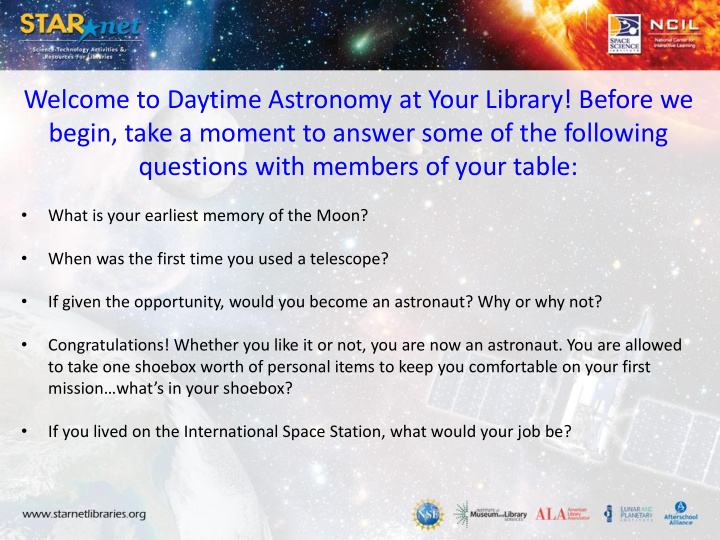



Welcome to Daytime Astronomy at Your Library! Before we begin, take a moment to answer some of the following questions with members of your table: • What is your earliest memory of the Moon? • When was the first time you used a telescope? • If given the opportunity, would you become an astronaut? Why or why not? • Congratulations! Whether you like it or not, you are now an astronaut. You are allowed to take one shoebox worth of personal items to keep you comfortable on your first mission…what’s in your shoebox? • If you lived on the International Space Station, what would your job be?
Dayt ytime Astronomy at Your Lib ibrary ry Saturday, June 24, 2017
Presenters NASA @ My Library Initiative/STAR_Net Project • Lainie Castle • Project Director for the American Library Association Public Programs Office • Paul Dusenbery • Director, National Center for Interactive Learning (NCIL)/Space Science Institute (SSI) • Anne Holland • Community Engagement Manager, NCIL/SSI • Keliann LaConte • Professional Development Manager, NCIL/SSI • Brooks Mitchell • Education Coordinator, NCIL/SSI ‹#›
Session Agenda • Welcome and Introductions • Background on the Solar Eclipse/Making Sun Cookies • Facilitated Hands-on Activities • Spectrum of Eclipse-related Resources • Safety While Solar Viewing • Outside Solar Viewing Stations • Close ‹#›
A Show of Hands • What kind of library do you come from? • Are you currently planning a program for the 2017 Great American Eclipse? • Did you receive an Eclipse Kit from us? ‹#›
Hands-on Activity Guide: Sun Cookies
Our Star, the Sun
Regions of the Sun Core Photosphere Radiative Zone Corona Convection Sunspot Zone
Seeing Spots
Sunspots: cool, dark, & magnetic
Magnetic Loops
Solar Prominences Earth-Sun distance not to scale
Total Solar Eclipse - 1999 Participate in the August 2017 Solar Eclipse!
http://www.scigames.org/apps.php
Facilitated Activity: Scale Model of Sun and Earth
Facilitated Activity: Eclipse Chalk Art ‹#›
Eclipse-related Resources ‹#›
Eclipse Resource Center ‹#›
STEM Activity Clearinghouse ‹#›
Safe Solar Viewing (Telescope and Binoculars) ‹#›
Safe Solar Viewing (Indirect Viewing) • Indirect viewing (not using a filter to look directly at the sun) is the safest way for young audiences to view the eclipse. • Create a pinhole projector (see the Clearinghouse for instructions), purchase a “ SunSpotter ”, use a colander, or even a cheese grater! ‹#›
Safe Solar Viewing (Glasses) • Do not view the partially eclipsed sun with regular sun glasses, no matter how dark • You must use special solar glasses, ISO certified 12312-2:2015 • You can also use a welders mask, but it MUST be rated 14 or higher. Most commercially available masks are NOT rated this high. Go to a specialty store • For glasses (and telescopes/binoculars) point the item towards the sun and place your hand where your eyes would be to test if there are any defects in your glasses/filter. If you see a pinpoint of light DO NOT USE THE ITEM. Not Cylons, probably … ‹#›
Come see us! • “High - impact STEM Events to Foster Collaboration” • McCormick Place, W196c • Sunday, 1:00-2:30 p.m. • NASA Booth 4051 • Giveaways, Hyperwall presentations, and more! ‹#›
Recommend
More recommend